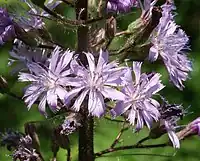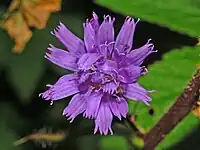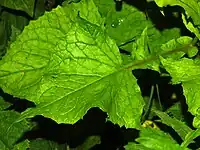| Cicerbita alpina | |
|---|---|
 | |
| Cicerbita alpina | |
| Scientific classification | |
| Kingdom: | Plantae |
| Clade: | Tracheophytes |
| Clade: | Angiosperms |
| Clade: | Eudicots |
| Clade: | Asterids |
| Order: | Asterales |
| Family: | Asteraceae |
| Genus: | Cicerbita |
| Species: | C. alpina |
| Binomial name | |
| Cicerbita alpina (L.) Wallr. 1822 | |
| Synonyms[2] | |
|
Synonymy
| |
Cicerbita alpina, commonly known as the alpine sow-thistle or alpine blue-sow-thistle[4] is a perennial herbaceous species of plant sometimes placed in the genus Cicerbita of the family Asteraceae, and sometimes placed in the genus Lactuca as Lactuca alpina.[5] It is native to upland and mountainous parts of Europe.
It was once used as an herb in Sami cooking, and known as jierja.[6]
Description
Cicerbita alpina on average reaches 80 centimetres (31 in) in height, with a minimum height of 50 cm (20 in) and a maximum height of 150 cm (59 in). The stem is erect and usually unbranched. It has glandular hairs and contains a white milky juice, a kind of latex. The alternate leaves are broad, triangular and clasping the stem, bluish-grey beneath, hairy along the veins and with toothed margins. The inflorescence is a panicle. Each composite flower is about 2.5 cm (1 in) wide and is set within a whorl of bracts. The individual blue-violet florets are tongue-like with a toothed, truncated tip, each having five stamens and a fused carpel. All the florets are ray florets; there are no disc florets. The seeds are clothed in unbranched hairs. The flowering period extends from June to September in the temperate northern hemisphere.[7]
Distribution and habitat
Cicerbita alpina grows on many mountains of Europe (the Alps, the Pyrenees, the northern Apennines, the Scandinavian Peninsula, Scotland (where it is endangered and found in only four known locations), the Carpathians and the Urals.[8] These plants can be found in alpine woods, besides streams, in rich-soil in hollows and in tall meadows, usually between 1,000 and 1,800 metres (3,300 and 5,900 ft) above sea level.[7]
Conservation
It became a protected species in the UK in 1975 under the Conservation of Wild Creatures and Wild Plants Act.[9]
Ecology
In Finland, this plant is known as "bear-hay" because the Eurasian brown bear feeds on it, as do elk and reindeer. People also sometimes make use of it and eat it raw or cooked in reindeer milk.[7]
Secondary metabolites
The edible shoots of Cicerbita alpina contain 8-O-Acetyl-15-beta-D-glucopyranosyllactucin, which causes the bitter taste of the vegetable, and caffeic acid derivatives chlorogenic acid, 3,5-dicaffeoylquinic acid, caffeoyltartaric acid, and cichoric acid.[10]
Gallery
 Flowers of Cicerbita alpina |
 Flower of Cicerbita alpina'' |
 Leaf of Cicerbita alpina'' |
References
- ↑ Collett, L. & Korpelainen, H. (2017). "Lactuca alpina". IUCN Red List of Threatened Species. 2017. Retrieved 24 June 2018.
- ↑ The Plant List, Lactuca alpina (L.) A.Gray
- ↑ The International Plant Names Index
- ↑ BSBI List 2007 (xls). Botanical Society of Britain and Ireland. Archived from the original (xls) on 2015-06-26. Retrieved 2014-10-17.
- ↑ Flann, C (ed) 2009+ Global Compositae Checklist
- ↑ Nilsson, Lena Maria; Dahlgren, Lars; Johansson, Ingegerd; Brustad, Magritt; Sjölander, Per; Guelpen, Bethany Van (18 February 2011). "Diet and lifestyle of the Sami of southern Lapland in the 1930s–1950s and today". International Journal of Circumpolar Health. 70 (3): 301–318. doi:10.3402/ijch.v70i3.17831. hdl:10037/4081. ISSN 2242-3982. PMID 21631968.
- 1 2 3 "Alpine Sowthistle". NatureGate. Retrieved 2013-12-24.
- ↑ "Plant & fungi species | Wild plants in Scotland | Welcome to Plantlife Scotland". Archived from the original on 2013-06-16. Retrieved 2013-06-06.
- ↑ "Caithness CWS - Caithness Field Club - Annual Bulletins - 1975 - October - Conservation".
- ↑ Fusani, P; Zidorn, C (2010). "Phenolics and a sesquiterpene lactone in the edible shoots of Cicerbita alpina (L.) Wallroth". Journal of Food Composition and Analysis (Amsterdam, the Netherlands). 23 (6): 658–663. doi:10.1016/j.jfca.2009.08.014. ISSN 0889-1575.
- Pignatti S. - Flora d'Italia - Edagricole – 1982. vol. III
